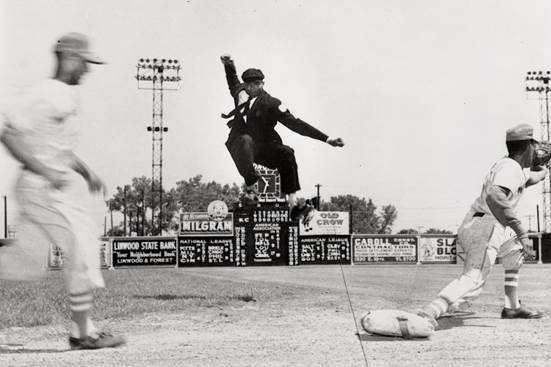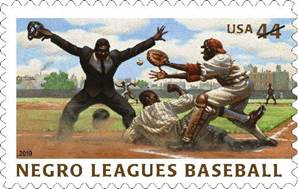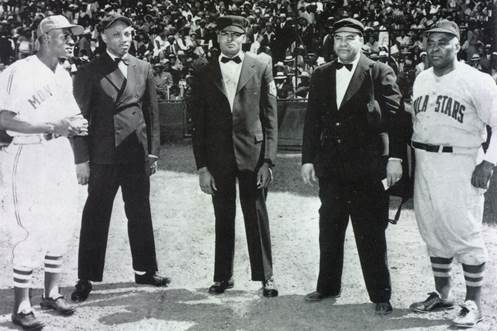I feel I must say something about the Royals. Then I will move on to some good news, a statue for umpire Bob Motley.
How About Those Royals? Lost in the box scores and division standings are some records and potential milestones that you may not have noticed. As of this writing:
On May 3, the Royals’ Nathan Karns became the most recent pitcher in major league history to strike out four batters in one inning. When I was a kid poring through a record book, I was curious when I saw that the strikeout record for an inning was four. That’s how I learned that when a hitter reaches first after the catcher misses the ball on a third strike, the pitcher is still credited with the strikeout. If the pitcher gets all of his actual outs by strikeouts, he has four total. It has happened 84 times. Karns now shares the record with the likes of Walter Johnson, Bob Gibson and Don Drysdale. No pitcher has ever had five strikeouts in an inning.
On May 5, Eric Hosmer hit the longest home run in the major leagues so far in 2017. He was at the K and the “true distance” was tracked at 469 feet. He beat out Jake Lamb by a foot to take the current lead. To see if Hosmer remains at number one, Google “ESPN Home Run Tracker” for more home run stats than you can imagine.
In a less publicized home run watch, I have spotted a couple of tweets tracking how Mike Moustakas is doing against Steve Balboni. “Bones” hit 36 homers in 1985, the most ever by a Royal (as you may recall from Hot Stove #38, the A’s Bob Cerv holds the KC major league record of 38 in 1958). The tracker is posted by writer Shaun Newkirk of RoyalsReview.com, and his update on May 9 shows Moose two homers ahead of Balboni’s pace in 1985. Also included are Gary Gaetti (35 in 1995) and John Mayberry (34 in 1975).

For you true nerds out there, MLB has a milestone tracker on stats that can take you down the rabbit hole for hours. At your leisure, Google “MLB Milestone Tracker.”
The MLB tracker even projects the date that a milestone will be reached. For example, here are some projections for Eric Hosmer this season. On June 3, Hos will get his 1000th hit, and on June 8, his 500th RBI. Both of these will be at the K. On June 16, he will be at Angels Stadium in Anaheim and hit his 109th home run to tie him with Bo Jackson for 11th in career Royals homers. The dates on the tracker change from day to day, and some of Hosmer’s have moved up as a result of his recent hot streak. On June 10, Rita and I will be at Petco Park in San Diego and see the Royals as part of our California five-stadium tour. If the projections are a little off on Hosmer, we may witness one or more of his milestones in San Diego. If he’s not traded.
The top anticipated milestone this year is hit number 3,000 for Adrian Beltre. The Texas Rangers’ star has been injured, but is expected back in late May. He currently has 2,942 hits, 591 doubles and 445 home runs. He should reach 3,000/600/450 in those stats this year. Only three others have done so: Hank Aaron, Stan Musial and Carl Yastrzemski. You can see this future Hall of Famer when Texas comes to town to play the Royals July 14-16.
Umpire Bob Motley and the Field of Legends: Bob Motley was born in 1923 near Selma, Alabama, and served in the first-ever black Marine regiment in WW II. While recovering from a bullet wound at a military hospital, he noticed a ball game outside his window and went out and volunteered to umpire. He loved it, and after settling in Kansas City, he started umpiring college and Ban Johnson games. In 1948, he became part of the regular crews umpiring in the Negro Leagues. His emphatic ball and strike calls, kicks, leaps and splits were in keeping with the passion and flair of the Negro Leagues. I’ll let these photos tell that story (also note the old-time KC ads on the stadium walls):


Motley tried to break the color line for umpires in the major leagues, but his only opportunity came during an umpires strike. He declined to cross the picket line. Emmett Ashford became the first black major league umpire in 1966.
A couple of years ago, I read Motley’s autobiography, Ruling Over Monarchs, Giants and Stars (written with his son Byron and published in 2007). He had stories to tell, and one of my favorites is about Buck O’Neil when he manager of the KC Monarchs. They both told the story, but remember the play differently. Buck says it was an argument over the infield fly rule. Motley says it was a close call at home plate. Either way, O’Neil said one of the magic words to Motley and was thrown out of a game for the only time in his career. After the game, Motley found that the only black hotel in Jacksonville was sold out and he did not have a place to stay. He mentioned it to Buck who said “Kid, no problem. Don’t worry, you can sleep with me.” Buck was never one to hold grudges.
In 1990, Motley joined Buck and others to found the Negro Leagues Baseball Museum. Bob Motley, from his book:
“I am most proud of and honored by a display case in the museum that contains my umpire uniform, gear, and other artifacts from my collection of personal items. Located in the museum’s centerpiece ‘Field of Legends,’ alongside bronze statues of Hall of Famers Josh Gibson and Martin Dihigo, my time capsule is a flattering tribute that tickles me to death every time I see it.”
After the Negro Leagues folded, Motley continued umpiring college games and in the Pacific Coast League. After serving as umpire-in-chief of the 1973 College World Series, he retired from the diamond and discovered a new passion – working with Ewing Kauffman as a member of the Royal Lancers to sell season tickets. He became the number-one salesman. He also made many good friends among the Royal Lancers, including Dick Davis who served on the City Council of Kansas City from 2011 to 2015. Late in his council term, Davis visited the NLBM with fellow councilman Jermaine Reed. Davis noticed the Motley display case and also that there was no umpire on the Field of Legends. Davis suggested to Reed that it might be a good idea to add a statue of Motley to complete the field.
After Davis left office in 2015, he mentioned to his wife that he regretted not having done anything about the Motley statue while on the council. She said why not do it now. So he is. Davis and many Royal Lancers and others have formed the nonprofit “Umpire Bob Motley Completes the Field of Legends” to raise $100,000 for the statue. Last month, I attended a fundraiser that included Davis, many Royal Lancers, Councilmen Jermaine Reed and Dan Fowler, Congressman Emanuel Cleaver, County Executive Frank White and KC-based sculptor Kwan Wu who created several of the statues in the Field of Legends and the one of George Brett at Kauffman Stadium. Also in attendance was Bob Motley, now 94 and the sole surviving umpire from the Negro Leagues.
The campaign is already close to its goal, and so Bob Motley will soon join the other twelve icons of the Negro Leagues on the Field of Legends: Nine fielders, including Satchel Paige pitching, Cool Papa Bell in the outfield and Josh Gibson catching; Buck O’Neil, manager; Martin Dihigo batting; and Rube Foster, league founder.

In 2010, the US Post Office issued two Negro Leagues stamps, one showing an umpire. The artist does not confirm that it is Motley, but based upon the calls and notes Motley received from people around the country, he rightfully thinks it was “inspired by” his style.

Buck O’Neil, Bob Motley and Congressmen Lewis and Clyburn: In my recent Hot Stove post about the Harry Truman dinner, I rhapsodized about the conversation on stage by Congressmen John Lewis and James Clyburn. What resonated with me was their continued optimism and hope after working on civil rights for over 50 years. The overall message was clear: love, forgiveness and nonviolence. And above all, continue the work and KEEP OUR EYES ON THE PRIZE.
As I read about Bob Motley, it occurred to me that he and Buck O’Neil were on the same page as Lewis and Clyburn. They just did it on the playing field instead of in politics. Jim Crow was the sad reality for Motley and O’Neil, but they always spoke with joy about their experiences in the Negro Leagues. Buck hinted at that in the title of his autobiography, I Was Right on Time. O’Neil and Motley both looked to the goal of being in the major leagues and kept their eye on that prize for the benefit of the next generation.
In an interview a few years ago, Byron Motley spoke about his father, “As far as carrying a grudge or being disappointed, not in the slightest. If he had, he certainly wouldn’t have lived to 90 years old. The bitterness would have ate him up inside.” And as Bob Motley says in his book about growing up in the Deep South, “I made it out of that hopelessness unscathed, and my life prospered in ways I would never have imagined.”
When Buck was (wrongfully) not voted into the Hall of Fame, his response was so Buck: “Don’t shed any tears. You think about this. Here I am, the grandson of a slave. And here the whole world was excited about whether I was going into the Hall of Fame or not. We’ve come a long ways.” But he also asks us to keep our eyes on the prize: “Learn your history. It’s a wonderful history. So many wonderful things have happened in the last 100 years. We still have a ways to go, but that’s your job, you and your children. We will get there. I know it.”
The photo below is from opening day in 1949. Buck is on the left, Motley in the center, and Oscar Charleston on the far right. Charleston can also be found in center field in the Field of Legends.

To finish this post, I pulled from the shelf my late mother’s copy of Buck’s I Was Right on Time. It’s a real keepsake – mom was a big fan of Buck’s, and the inside front cover is inscribed “To Katie Shalton, Buck O’Neil, 6-22-96.” In the final chapter, Buck talks of returning to Sarasota High School to get his diploma, some 69 years after he was unable to go to the school because of segregation. A huge crowd celebrated with him and he took pride in the way a speaker paraphrased an old poem – he compared Buck to the old man who swims across a wide chasm, only to start building a bridge back to the other side so that men younger than him will have an easier time crossing. Buck ends the book as he often ended his speeches – by asking folks to hold hands and sing with him, “Just remember: The greatest thing in all my life is loving you. Sing it. Together.”
Hope. Love. Optimism. Forgiveness.
Lewis. Clyburn. Motley. O’Neil.
Four remarkable human beings.
[The video of the conversation between Lewis and Clyburn is now available on YouTube. It is 43 minutes long, the first 14 minutes being the awards presentation, then the next 29 being the best minutes you will spend in a long time. You will thank me.]
One thought on “Hot Stove #41 – How About Those Royals? How About Bob Motley?”
Comments are closed.